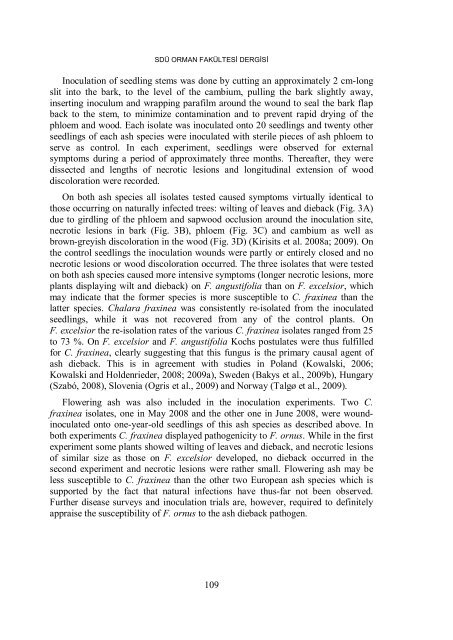sdu faculty of forestry journal special edition 2009 - Orman Fakültesi
sdu faculty of forestry journal special edition 2009 - Orman Fakültesi
sdu faculty of forestry journal special edition 2009 - Orman Fakültesi
You also want an ePaper? Increase the reach of your titles
YUMPU automatically turns print PDFs into web optimized ePapers that Google loves.
SDÜ ORMAN FAKÜLTESİ DERGİSİ<br />
Inoculation <strong>of</strong> seedling stems was done by cutting an approximately 2 cm-long<br />
slit into the bark, to the level <strong>of</strong> the cambium, pulling the bark slightly away,<br />
inserting inoculum and wrapping parafilm around the wound to seal the bark flap<br />
back to the stem, to minimize contamination and to prevent rapid drying <strong>of</strong> the<br />
phloem and wood. Each isolate was inoculated onto 20 seedlings and twenty other<br />
seedlings <strong>of</strong> each ash species were inoculated with sterile pieces <strong>of</strong> ash phloem to<br />
serve as control. In each experiment, seedlings were observed for external<br />
symptoms during a period <strong>of</strong> approximately three months. Thereafter, they were<br />
dissected and lengths <strong>of</strong> necrotic lesions and longitudinal extension <strong>of</strong> wood<br />
discoloration were recorded.<br />
On both ash species all isolates tested caused symptoms virtually identical to<br />
those occurring on naturally infected trees: wilting <strong>of</strong> leaves and dieback (Fig. 3A)<br />
due to girdling <strong>of</strong> the phloem and sapwood occlusion around the inoculation site,<br />
necrotic lesions in bark (Fig. 3B), phloem (Fig. 3C) and cambium as well as<br />
brown-greyish discoloration in the wood (Fig. 3D) (Kirisits et al. 2008a; <strong>2009</strong>). On<br />
the control seedlings the inoculation wounds were partly or entirely closed and no<br />
necrotic lesions or wood discoloration occurred. The three isolates that were tested<br />
on both ash species caused more intensive symptoms (longer necrotic lesions, more<br />
plants displaying wilt and dieback) on F. angustifolia than on F. excelsior, which<br />
may indicate that the former species is more susceptible to C. fraxinea than the<br />
latter species. Chalara fraxinea was consistently re-isolated from the inoculated<br />
seedlings, while it was not recovered from any <strong>of</strong> the control plants. On<br />
F. excelsior the re-isolation rates <strong>of</strong> the various C. fraxinea isolates ranged from 25<br />
to 73 %. On F. excelsior and F. angustifolia Kochs postulates were thus fulfilled<br />
for C. fraxinea, clearly suggesting that this fungus is the primary causal agent <strong>of</strong><br />
ash dieback. This is in agreement with studies in Poland (Kowalski, 2006;<br />
Kowalski and Holdenrieder, 2008; <strong>2009</strong>a), Sweden (Bakys et al., <strong>2009</strong>b), Hungary<br />
(Szabó, 2008), Slovenia (Ogris et al., <strong>2009</strong>) and Norway (Talgø et al., <strong>2009</strong>).<br />
Flowering ash was also included in the inoculation experiments. Two C.<br />
fraxinea isolates, one in May 2008 and the other one in June 2008, were woundinoculated<br />
onto one-year-old seedlings <strong>of</strong> this ash species as described above. In<br />
both experiments C. fraxinea displayed pathogenicity to F. ornus. While in the first<br />
experiment some plants showed wilting <strong>of</strong> leaves and dieback, and necrotic lesions<br />
<strong>of</strong> similar size as those on F. excelsior developed, no dieback occurred in the<br />
second experiment and necrotic lesions were rather small. Flowering ash may be<br />
less susceptible to C. fraxinea than the other two European ash species which is<br />
supported by the fact that natural infections have thus-far not been observed.<br />
Further disease surveys and inoculation trials are, however, required to definitely<br />
appraise the susceptibility <strong>of</strong> F. ornus to the ash dieback pathogen.<br />
109








